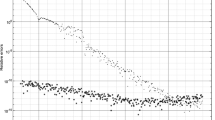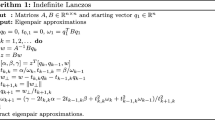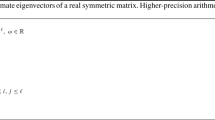Abstract
The Lanczos method is often used to solve a large scale symmetric matrix eigenvalue problem. It is well-known that the single-vector Lanczos method can only find one copy of any multiple eigenvalue (unless certain deflating strategy is incorporated) and encounters slow convergence towards clustered eigenvalues. On the other hand, the block Lanczos method can compute all or some of the copies of a multiple eigenvalue and, with a suitable block size, also compute clustered eigenvalues much faster. The existing convergence theory due to Saad for the block Lanczos method, however, does not fully reflect this phenomenon since the theory was established to bound approximation errors in each individual approximate eigenpairs. Here, it is argued that in the presence of an eigenvalue cluster, the entire approximate eigenspace associated with the cluster should be considered as a whole, instead of each individual approximate eigenvectors, and likewise for approximating clusters of eigenvalues. In this paper, we obtain error bounds on approximating eigenspaces and eigenvalue clusters. Our bounds are much sharper than the existing ones and expose true rates of convergence of the block Lanczos method towards eigenvalue clusters. Furthermore, their sharpness is independent of the closeness of eigenvalues within a cluster. Numerical examples are presented to support our claims.

Similar content being viewed by others
Notes
If \(k=\ell \), we may say that these angles are between \({\mathcal {X}}\) and \({\mathcal {Y}}\).
In fact, a result due to Chebyshev himself says that if \(p(t)\) is a polynomial of degree no bigger than \(j\) and \(|p(t)|\le 1\) for \(-1\le t\le 1\), then \(|p(t)|\le |{\fancyscript{T}}_j(t)|\) for any \(t\) outside \([-1,1]\) [4, p. 65].
By convention, \(\prod _{j=1}^0(\cdots )\equiv 1\).
A by-product of this is that \(c=1\) if \(k=\ell \).
References
Bhatia, R.: Matrix Analysis. Graduate Texts in Mathematics, vol. 169. Springer, New York (1996)
Bhatia, R., Davis, C., Koosis, P.: An extremal problem in Fourier analysis with applications to operator theory. J. Funct. Anal. 82, 138–150 (1989)
Bhatia, R., Davis, C., McIntosh, A.: Perturbation of spectral subspaces and solution of linear operator equations. Linear Algebra Appl. 52–53, 45–67 (1983)
Cheney, E.W.: Introduction to Approximation Theory, 2nd edn. Chelsea Publishing Company, New York (1982)
Cullum, J.K., Donath, W.E.: A block Lanczos algorithm for computing the \(q\) algebraically largest eigenvalues and a corresponding eigenspace of large, sparse, real symmetric matrices. In: Decision and Control including the 13th Symposium on Adaptive Processes, 1974 IEEE Conference on, vol. 13, pp. 505–509 (1974)
Cullum, J.K., Willoughby, R.A.: Lanczos Algorithms for Large Symmetric Eigenvalue Computations, vol. I: Theory. SIAM, Philadelphia (2002)
Davis, C., Kahan, W.: The rotation of eigenvectors by a perturbation. III. SIAM J. Numer. Anal. 7, 1–46 (1970)
Demmel, J.: Applied Numerical Linear Algebra. SIAM, Philadelphia (1997)
Golub, G.H., Underwood, R.R.: The block Lanczos method for computing eigenvalues. In: Rice, J.R. (ed.) Mathematical Software III, pp. 361–377. Academic Press, New York (1977)
Golub, G.H., Van Loan, C.F.: Matrix Computations, 3rd edn. Johns Hopkins University Press, Baltimore (1996)
Jia, Z., Stewart, G.W.: An analysis of the Rayleigh–Ritz method for approximating eigenspaces. Math. Comput. 70, 637–647 (2001)
Kaniel, S.: Estimates for some computational techniques in linear algebra. Math. Comput. 20(95), 369–378 (1966)
Kuijlaars, A.B.J.: Which eigenvalues are found by the Lanczos method? SIAM J. Matrix Anal. Appl. 22(1), 306–321 (2000)
Kuijlaars, A.B.J.: Convergence analysis of Krylov subspace iterations with methods from potential theory. SIAM Rev. 48(1), 3–40 (2006)
Lanczos, C.: An iteration method for the solution of the eigenvalue problem of linear differential and integral operators. J. Res. Nat. Bur. Standards 45, 255–282 (1950)
Li, R.C.: Matrix perturbation theory. In: Hogben, L., Brualdi, R., Greenbaum, A., Mathias, R. (eds.) Handbook of Linear Algebra, p. Chapter 15. CRC Press, Boca Raton (2006)
Li, R.C.: On Meinardus’ examples for the conjugate gradient method. Math. Comput. 77(261), 335–352 (2008). Electronically published on September 17, 2007
Li, R.C.: Sharpness in rates of convergence for symmetric Lanczos method. Math. Comput. 79(269), 419–435 (2010)
Li, R.C., Zhang, L.H.: Convergence of block Lanczos method for eigenvalue clusters. Technical Report 2013–03, Department of Mathematics, University of Texas at Arlington (2013). Available at http://www.uta.edu/math/preprint/
Paige, C.C.: The computation of eigenvalues and eigenvectors of very large sparse matrices. Ph.D. thesis, London University, London, England (1971)
Parlett, B.N.: The symmetric eigenvalue problem. SIAM, Philadelphia (1998). This SIAM edition is an unabridged, corrected reproduction of the work first published by Prentice-Hall Inc. Englewood Cliffs, New Jersey (1980)
Saad, Y.: On the rates of convergence of the Lanczos and the block-Lanczos methods. SIAM J. Numer. Anal. 15(5), 687–706 (1980)
Stewart, G.W., Sun, J.G.: Matrix Perturbation Theory. Academic Press, Boston (1990)
Wedin, P.Å.: On angles between subspaces. In: Kågström, B., Ruhe, A. (eds.) Matrix Pencils, pp. 263–285. Springer, New York (1983)
Ye, Q.: An adaptive block Lanczos algorithm. Numer. Algoritm. 12, 97–110 (1996)
Acknowledgments
The authors are grateful to both reviewers for their constructive comments/suggestions that improve the presentation considerably. Li is supported in part by NSF grants DMS-1115834 and DMS-1317330, and a Research Gift grant from Intel Corporation, and and NSFC grant 11428104. Zhang is supported in part by NSFC grants 11101257, 11371102, and the Basic Academic Discipline Program, the 11th five year plan of 211 Project for Shanghai University of Finance and Economics.
Author information
Authors and Affiliations
Corresponding author
Rights and permissions
About this article
Cite this article
Li, RC., Zhang, LH. Convergence of the block Lanczos method for eigenvalue clusters. Numer. Math. 131, 83–113 (2015). https://doi.org/10.1007/s00211-014-0681-6
Received:
Revised:
Published:
Issue Date:
DOI: https://doi.org/10.1007/s00211-014-0681-6




